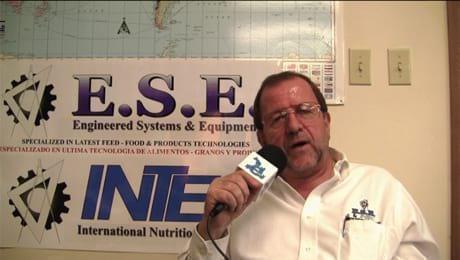Explore all the information on
Feed processing and manufacturing
Welcome to the page about Feed processing and manufacturing of Engormix; a source of knowledge on Feed processing and manufacturing.
Dear colleagues and professionals in the feed manufacturing industry, The image below shows a broken pellet die. I already know the root cause, but I’m sharing this to spark a technical discussion and learn from your insights. - What do you think could lead to such damage? - Have you faced similar issues? What solutions worked for you? I’d love to hear your thoughts and experiences. Let’s turn this into a learning opportunity for...
Comments : 0
Recommendations: 0
Extreme rains in northwest Iowa have caused instances of stored grain being covered with floodwater. According to current Food and Drug Administration policy, grain inundated by uncontrolled river or stream water is considered adulterated and must be destroyed. The current situation is one of river water flooding rather than of rain-driven pooled water in low ground, for which there are salvage options. River-based floodwaters can bring in many hazards and rapid spoilage. Flooding...
Comments : 0
Recommendations: 0
Recommended events
January 26, 2026
United States - Georgia - Atlanta
In the world of animal feed manufacturing, some parameters shout: protein levels, energy values, additive profiles. Others whisper, quietly shaping performance from behind the scenes. Particle size is one of those silent drivers. And yet, for monogastric species like pigs and poultry, it can be the difference between optimal feed conversion and costly inefficiencies. I’ve spent over three decades in feed process technology, and if there’s one...
Comments : 0
Recommendations: 2
1. Introduction Influenza A virus (IAV) is an enveloped RNA virus, a member of the Orthomyxoviri dae family, and is known to infect humans, mammals, and birds [1]. The virus is subtyped based on the antigenic cross-reactivity and sequence identity of two surface glycoproteins, namely, hemagglutinin (HA) and neuraminidase (NA) [2]. Excluding the recently identified H17N10 and H18N11 in bats, 16 HA and 9NAIAV subtypes have been identified in mammals and birds to date...
Comments : 1
Recommendations: 1
ARLINGTON, Va. – The American Feed Industry Association (AFIA) is pleased to announce that the International Feed Industry Federation (IFIF) unanimously elected Constance Cullman, President & CEO of the AFIA, as chair for 2026–27 in Rome, Italy during the annual IFIF meeting last week. She will succeed...
Comments : 0
Recommendations: 2
Lin Yuzhou, General Manager Assistant, Sifang Machinery, comments on the use of low temperatures in the rendering process, as well as its cost and environmental benefits, during this Engormix interview at REAM 2025 in Guadalajara, Mexico. ...
Comments : 0
Recommendations: 0
.jpg&w=3840&q=75)

Lifecycle data on the sustainability of rendered products
Suggested link
Charles Starkey (VP of Scientific and Regulatory Affairs, NARA) comments on NARA's initiatives, as well as collaboration between organizations across the rendering industry, during this Engormix interview at REAM 2025 in Guadalajara, Mexico. ...
Comments : 0
Recommendations: 0
Dana Johnson Downing (VP of International Programs, NARA) comments on their educational project, Rendering University, and its upcoming official launch, during this Engormix interview at REAM 2025 in Guadalajara, Mexico. ...
Comments : 0
Recommendations: 0
Charles Starkey (VP of Scientific and Regulatory Affairs, NARA) discusses his REAM 2025 presentation on biocircularity and sustainability in this Engormix interview. ...
Comments : 0
Recommendations: 0
Ethan Carter (Advisor, Darling Ingredients Inc.) explains how the rendering industry offers sustainable solutions and benefits during this Engormix interview at REAM 2025 in Guadalajara, Mexico. ...
Comments : 0
Recommendations: 0
.jpg&w=3840&q=75)

Lifecycle data on the sustainability of rendered products
Suggested link
I. INTRODUCTION Whole grain feeding (WGF) involves the partial substitution of ground grain with whole grain in boiler diets. Whole grain (WG), usually wheat, may be added either prior to (prepellet) or following (post-pellet) steam-pelleting. WGF generates heavier and presumably more functional gizzards, which are thought to be the genesis of responses in feed conversion ratios (FCR) and energy utilisation (Liu et al., 2015). However, post-pellet WGF also provides broilers with the...
Comments : 0
Recommendations: 0
Among the many quality criteria in animal feed production, pellet durability is often cited as one of the most critical. And rightly so: fragile pellets tend to generate too much dust and fines, which can impact feed intake, zootechnical performance, and even trigger complaints from farmers. It’s no surprise, then, to see a growing number of posts, articles, and expert opinions stressing the importance of durability and how to improve it. But behind this apparent consensus...
Comments : 0
Recommendations: 1
Measures to improve bird performance have been sought due to the imminent phase out of in-feed antibiotics in poultry and continued demand for higher poultry feeding efficiency. Promotion of gizzard development by physical structure of feed ingredients or addition of dietary fibre is one such strategy with the hypothesis that larger ingredient particles and higher fibre enhance digestive enzyme secretion and feed efficiency in broilers (Kheravii et al., 2017; and Svihus, 2011). This study...
Comments : 0
Recommendations: 0
In this interview, Christian Rabe, Head of Feed Technology at Evonik Animal Nutrition, shares practical insights on key issues like mixing homogeneity, dosing accuracy, and the technological solutions that help feed mills enhance efficiency without compromising quality. ...
Comments : 0
Recommendations: 3
.jpg&w=3840&q=75)

Lifecycle data on the sustainability of rendered products
Suggested link
INTRODUCTION Feed particle size is an often-overlooked aspect of poultry production. Producers should not assume that feed is of a uniform size and homogeneously mixed, or that the feed mill is providing the ideal mix of particles in a ration. Feed particles range in size from very fine to coarse, and different grinding methods will result in different particle size distributions. Differences in particle size within a ration can affect both the digestive system and the...
Comments : 0
Recommendations: 1
John Boney (Penn State University) discusses performance, body weight, and feed conversion ratio when feeding mash compared to pellets in this Engormix interview during IPPE 2025 in Atlanta, USA....
Comments : 2
Recommendations: 1
1. Introduction Chickens have a well-developed trichromatic vision system composed of diverse photoreceptors and cones [1], allowing them to perceive a broad range of the color spectrum [2]. Chickens can see in ultraviolet wavelengths and perceive colors that are not visible to most mammals [3], including humans [4]. The chickens’ sharp visual capabilities allow them to effectively survey their surroundings and localize feed [5,6]. In addition, broiler chickens have shown...
Comments : 1
Recommendations: 2
1. Introduction Soybean expeller (SBE), a by-product obtained during the extruding-expelling process of soybean oil extraction [1], is highly valued as a protein-rich component in animal feed and soy-based food products [2–5]. In Argentina, nearly one million tons of SBE are produced annually [6] in 373 extruding-expelling facilities, primarily located in the Pampa’s region [7]. The average composition of SBE in Argentina is 7.2% moisture, 44.2% protein, and 8.1% residual...
Comments : 0
Recommendations: 1
.jpg&w=3840&q=75)

Lifecycle data on the sustainability of rendered products
Suggested link
ARLINGTON, Va. – May 21, 2025 – The Institute for Feed Education and Research (IFEEDER) held its Board of Trustees annual meeting on Tuesday to discuss its current projects and install new Board leadership and trustees.
"IFEEDER has made significant progress in...
Comments : 0
Recommendations: 0
ARLINGTON, Va. – May 21, 2025 – The American Feed Industry Association (AFIA) has released its 2025-26 policy priorities, reaffirming the animal food industry’s commitment to advancing policies that improve the business environment for U.S. animal food manufacturers. The new policy agenda focuses on improving the regulatory environment for new ingredients, expanding access to animal food solutions and enhancing market competitiveness while promoting feed...
Comments : 0
Recommendations: 0


















.jpg&w=3840&q=75)








